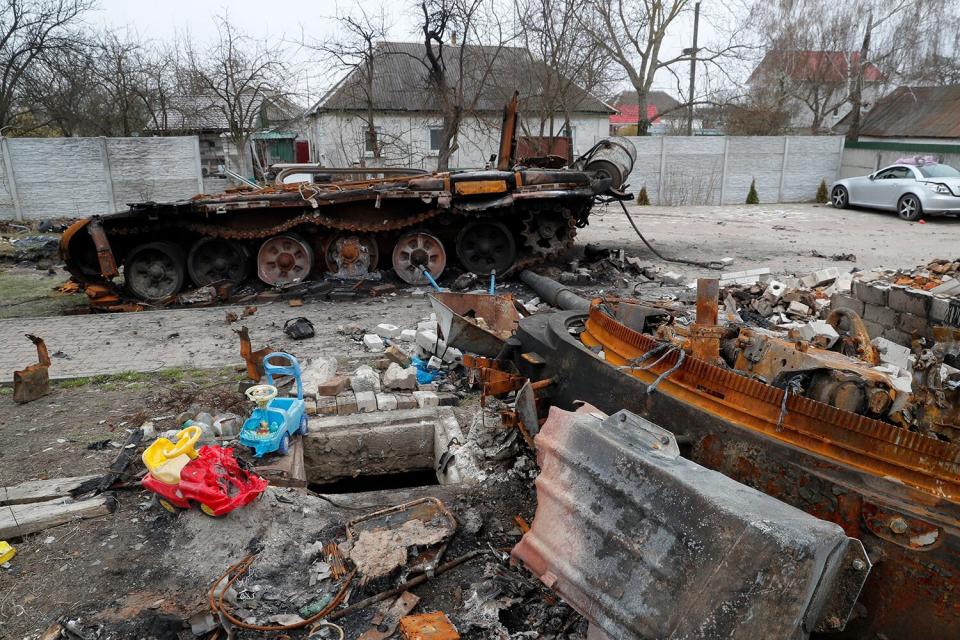This Ukrainian Software Engineer Uses Drones to Help Destroy Russian Tanks

In the face of war in his home country, Ukrainian software engineer Oleksandr Radzikhovskiy has turned his passion into a purpose — protecting other people in the process.
Before Russia launched its invasion on Feb. 24, Radzikhovsky was a drone enthusiast, flying them for fun as a hobby. But now as a member of the Ukrainian resistance, Radzikhovsky discovered he could use his knowledge of the remotely controlled machines for another purpose.
In an interview this week with CNN Newsroom, Radzikhovsky shared footage from the drones that he said he's been using to help destroy Russian tanks, and he explained how they're put to use to "document Russian movements."
Radzikhovsky told CNN he and other drone operators are able to capture footage of Russian tanks from the air, then they pass the video along to Ukrainian forces so the tanks can be stopped.
RELATED: How Children Are Coping in the Aftermath of Russia's Brutal Occupation of One Ukrainian City
Radzikhovsky emphasized that though he may be an engineer, he's just a civilian and he feels this is how he's doing his part for his country. "I keep myself protected and our members as well," he said. "Our main objective is total resistance."
Even as a civilian, Radzikhovsky is at risk, he said.
He noted to CNN anchor Jim Acosta that there's a reason he wears a bulletproof vest: Though the drones can fly without a pilot, they have a limited range and need to be relatively close to the tanks in order to capture video. But he knows that Russian forces "don't like" that Ukrainians can see their movements and haven't hesitated to use violence.
Still, Radzikhovsky said on CNN, "The main task is to keep us safe. You need to stay alive for the whole duration to conduct these kinds of flights."

SERGEY DOLZHENKO/EPA-EFE/Shutterstock Debris of a destroyed Russian tank sits in the yard of a private house in the Bohdanivka village in Ukraine in April.
Since war broke out in Ukraine, thousands of civilians have been killed or wounded, including children, the United Nations says — with millions of others forced to flee or suffering under occupation.
"You don't know where to go, where to run, who you have to call. This is just panic," Liliya Marynchak, a 45-year-old teacher from Ivano-Frankivsk, Ukraine, previously told PEOPLE of the moment her city was bombed.
The country's government, led by President Volodymyr Zelenskyy, urged civilians who remain in Ukraine to join the resistance at the same time that he has called for peace talks with Russia. Many fighting-fit Ukrainian men were also placed under a mobilization order should they have to join the military.
Among the civilian defenders are Ukrainians like Alexander Nosachenko, a prominent businessman who trained as a sniper to join the fight, he previously told PEOPLE.
"I wanted to master this just for the [sake] of knowing that in case a D-Day comes then you're prepared," he said of his riflery skills. "No matter how weird it sounds, this day came."
RELATED: Ukraine's First Lady on the Moment 'I Let Go of My Emotions' and What Husband Said as War Began
In an interview in March from the capital of Kyiv, Nosachenko said then that civilians — like drone enthusiast Radzikhovsky — had been instrumental in their efforts against Russia.
In addition to the drone flights, civilians were stationed to monitor for opposing tanks or armored vehicles which they then flagged to channels within Ukraine's artillery, sending photos, videos and geographic coordinates, Nosachenko said.
There is some verification and then, within minutes, "the bombs are there," Nosachenko said.
"This is the reason why so many Russian columns of armored vehicles, tanks were just destroyed," he said. They had already struck some 1,300 targets.
The Russian attack on Ukraine is an evolving story, with information changing quickly. Follow PEOPLE's complete coverage of the war here, including stories from citizens on the ground and ways to help.

